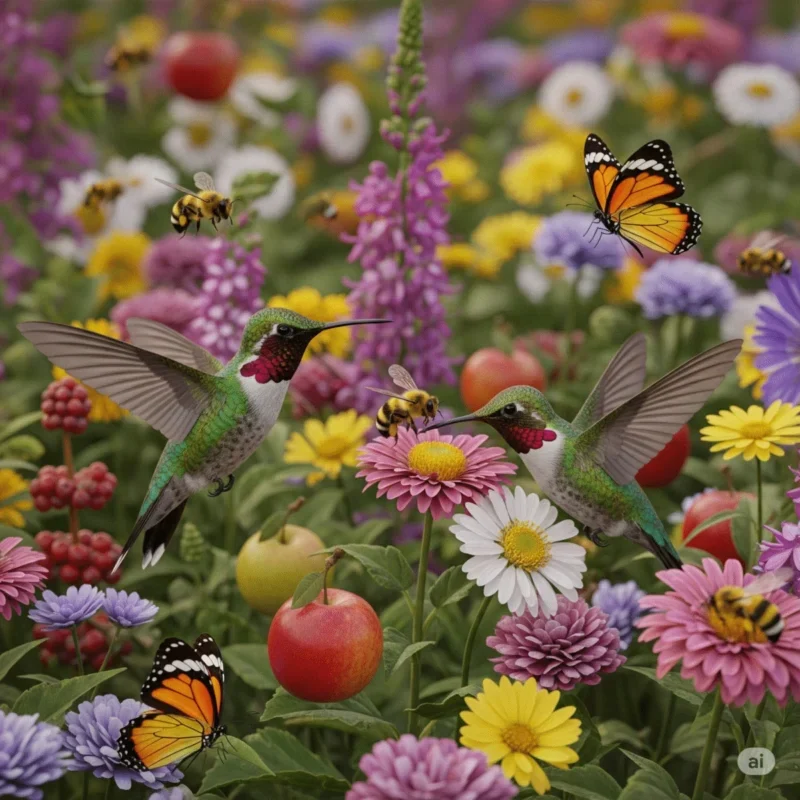(Or: How Tiny Birds Help Keep Entire Ecosystems Blooming)
Think of hummingbirds as nature’s most efficient flying pollination machines. While bees often get most of the credit for pollination services, hummingbirds play a unique and irreplaceable role in maintaining the health and diversity of ecosystems across the Americas. Their contribution to plant reproduction has shaped the evolution of hundreds of plant species and continues to influence the development of new flower varieties.
Understanding the Basics
Before we dive into the specifics of hummingbird pollination, let’s understand what makes these birds such effective pollinators. Unlike insects, hummingbirds have excellent color vision, particularly in the red spectrum, and possess long bills and the ability to hover with precision. These adaptations allow them to access flowers that most insects cannot, creating unique pollination partnerships with specific plant species.
Consider how a typical pollination interaction occurs: As a hummingbird feeds, pollen grains attach to its bill and feathers. When it visits the next flower, some of this pollen transfers to the new flower’s stigma, enabling fertilization. This seemingly simple process, repeated thousands of times daily, helps maintain the genetic diversity and reproduction of countless plant species.
The Specialized Partnership
Over millions of years, many plants have evolved specific adaptations to attract hummingbird pollinators. These “ornithophilous” (bird-pollinated) flowers share several common characteristics:
- Tubular shapes that match hummingbird bill lengths
- Bright red or orange colors that attract birds but not bees
- Abundant nectar production to fuel their high-energy pollinators
- Lack of landing platforms (unlike bee-pollinated flowers)
This specialization creates mutual dependence – the plants rely on hummingbirds for reproduction, while the birds depend on the flowers for sustenance. It’s a beautiful example of coevolution, where both species have influenced each other’s development over time.
Beyond Simple Pollination
The impact of hummingbird pollination extends far beyond the simple transfer of pollen. These birds play several crucial ecological roles:
First, they serve as long-distance pollen carriers, moving genetic material between plant populations that might otherwise remain isolated. This genetic mixing helps maintain healthy, resilient plant populations.
Second, their pollination activities support entire ecosystems. The plants they pollinate provide food and shelter for countless other species, from insects to mammals.
Third, they help maintain biodiversity by pollinating rare and specialized plant species that other pollinators cannot effectively service.
Seasonal Timing and Migration
The relationship between hummingbirds and their target flowers shows remarkable synchronization. Plant flowering times often coincide precisely with hummingbird migration patterns, creating “nectar corridors” that support the birds’ long-distance travels while ensuring reliable pollination for the plants.
This timing reflects millions of years of coevolution, resulting in a delicate balance that climate change now threatens to disrupt. When flowering times shift due to changing weather patterns, it can create mismatches between plant and pollinator schedules.
Urban Adaptation and Conservation
In our modern world, hummingbird pollination services extend into urban and suburban environments. Garden flowers, both native and exotic, benefit from hummingbird visits, though native plants typically provide better support for local ecosystems.
Conservation of hummingbird pollinators requires protecting both the birds and their target plants. This means preserving natural habitats, maintaining nectar corridors along migration routes, and supporting native plant populations in developed areas.
The Economic Value
While difficult to quantify precisely, the economic value of hummingbird pollination services is substantial. Consider the following benefits:
- Agricultural pollination of certain crops
- Maintenance of forest ecosystems
- Support of ornamental plant reproduction
- Contribution to ecotourism
These services contribute significantly to ecosystem stability and human economic activities, though they often go unrecognized.
Future Challenges
Climate change, habitat loss, and other environmental pressures threaten the delicate balance between hummingbirds and their partner plants. As temperatures warm and rainfall patterns shift, some plant species may flower at different times or move to new locations, potentially disrupting long-established pollination relationships.
Conclusion: Nature’s Perfect Pollination Partners
The role of hummingbirds in ecosystem pollination represents one of nature’s most elegant examples of mutual dependence and adaptation. These tiny birds, through countless daily flower visits, help maintain the health and diversity of entire ecosystems.
Remember: When you observe a hummingbird moving from flower to flower, you’re witnessing a pollination partnership that has evolved over millions of years and continues to shape the natural world around us.


